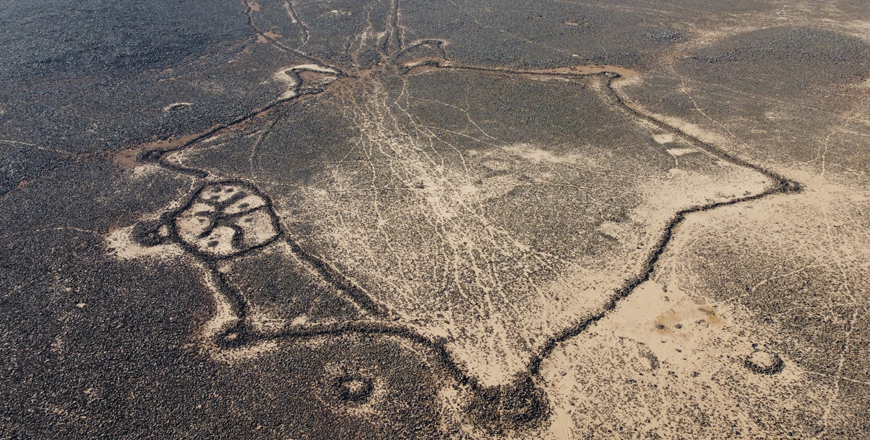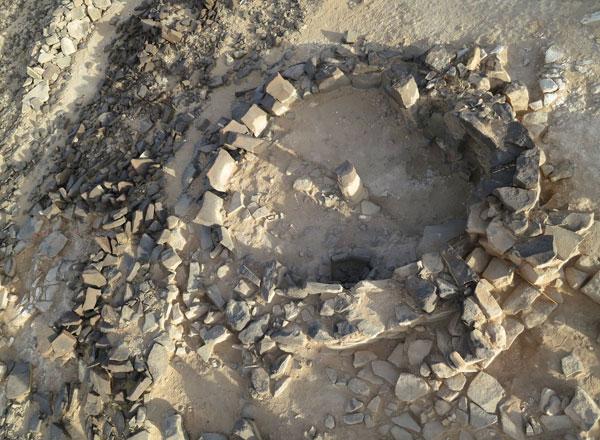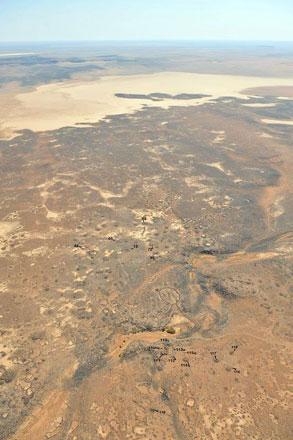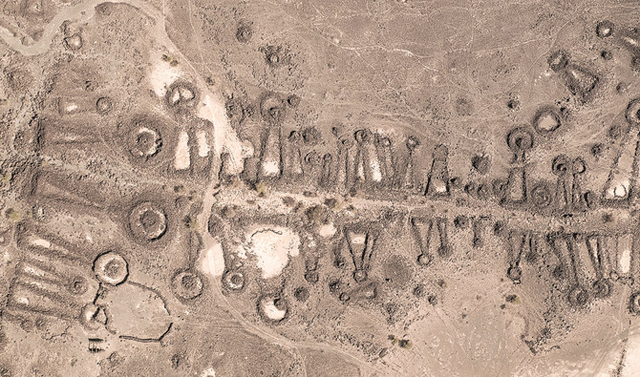You are here
‘Kites in Context’ project: Focusing on Ancient Jordanian desert kites
By Saeb Rawashdeh - May 08,2024 - Last updated at May 08,2024

An aerial view of a desert kite in the Black Desert in eastern Jordan. Desert kites were used as traps to hunt down wild animals in the Neolithic Period (Photo courtesy of Kites in Context project)
AMMAN — Desert kites were used for hunting of game animals during the Neolithic period as well as later periods and they were discovered not only in the Middle East, but also in Armenia and central Asia. Another theory is that the desert kites, stone structures that are hundreds of metres long and look like kites from air, had a function to keep domesticated animals in an enclosure.
“Kites in Context” is a project launched by a group of scholars who spent years studying desert kites in Jordan, particularly in the Black Desert of eastern Jordan. The professor of Archaeology of Southern Levant from The University of Chicago, York Rowan, and Postdoctoral Fellow from University of Pennsylvania, Austin Hill, are co-directors of the project.
The main focus of the research is in the area of Wisad Pools and Wadi Qattafi where drones were used for the aerial survey. Satellite imagery has no as high resolution as drones used to map ancient landscape.
"In 2022 we had visited as many of the kites as possible [n = 15] in the two easternmost chains, recording high-resolution mapping data sufficient to produce high-resolution, spatially accurate, and undistorted orthophotographs and accurate digital elevation models [DEMs], as well as oblique images that can serve as a visualisation of these features for publication and public presentation," said Rowan.
In 2023, the team continued the mapping project by visiting additional kite enclosures and mapping other ancient features on the landscape.
"The 2023 aerial survey was hampered by factors that limited the amount of work we could accomplish. First, the surprising weather for late May and early June —dust and lightning storms, followed by days of rain and eventual flooding of our campsite — caused a delay in the drone mapping program and the loss of five flight days, at significant cost," Hill remembered.
The team mapped 14 so-called wheels and 12 kite enclosers, as well as a few anthropogenic structures.
"During the 2023 season, we excavated two cells of the next kite in the chain, and we excavated two prehistoric structures we hoped would be contemporaneous with the kites. The two cells selected for excavation were undisturbed by later rebuilding, reuse, or looting," Rowan said, adding that Cell 4 was of interest not only because it was intact but also because the wall leading into the cell from the enclosure wall was clearly visible.
Cell 4 is approximately 6.0–6.5 metres in exterior diameter.
"We excavated the eastern half of the cell to about a metre below the surface of the cell’s interior, removing an enormous amount of stone that did not represent a clear wall. Instead, it appears that after a pit was dug, large stones were deposited around it, and heaps of stone were then piled on top," Hill said.
On the other hand, Cell 7 was selected not only because the surrounding walls appeared to be in good shape but also because the team noticed that some cells had an unusual “threshold” stone —a large, flat stone intentionally set at the entrance to the cell.
"Bisecting the cell, northeast to southwest, across the centre of this threshold stone exposed a built wall on the cell’s interior. Bedrock lay only 60 cm below the cell’s interior sediments, suggesting that the massive amount of stone filling the cell was collapsed from the walls built to prevent gazelles from jumping out once inside the cell [trap], " Rowan explained, adding that on the exterior, below the threshold stone, a short incline was built with large and medium-sized cobbles, creating a ramp up to the cell pit.
The archaeological team found no artefacts in the cells.
Two structures were also excavated: "Structure 1 spanned 8 metres across, including a small, circular exterior feature attached to the south end of the structure. The structure was sectioned down the middle, and its eastern half was excavated," said Rowan, adding that the north end of the structure included a petroglyph depicting a kite on a loose large stone.
The main structure was defined by an alignment of large, upright stones demarcating a wall. "Excavating around the exterior of the large upright stones, we found stones aligned as a foundation or buttressing to the upright stones," Hill explained, adding that these wall supports extended 0.7–1.0 metres in width around the upright structure wall.
The courtyard or open-air space southeast of the circular structure contained many lithic artifacts, particularly drills, suggesting its use as a workspace, scholars said.
Related Articles
AMMAN — When a group of scholars in 2008 began to work together in the Black Desert (eastern Jordan), they found many piles of rocks that on
AMMAN — “The question of why there are no gazelles represented in the petroglyphs [designs pecked into a stone surface] remains puzzling,” s
AMMAN — Desert kites had been determined by the social and economic organisation of the hunters living in desolated areas of the Arabian Pen


















